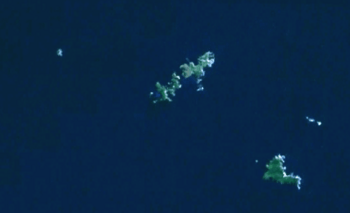Mokohinau Islands facts for kids
|
Māori: Mokohinau
|
|
|---|---|
 |
|
| Geography | |
| Coordinates | 35°55′S 175°07′E / 35.917°S 175.117°E |
| Area | 1.6 km2 (0.62 sq mi) |
| Highest elevation | 136 m (446 ft) |
| Administration | |
| Demographics | |
| Population | 0 |
The Mokohinau Islands (also called Pokohinau) are a small group of islands located off the northeast coast of New Zealand's North Island. These islands are about 100 kilometers (62 miles) northeast of Auckland. They are also 21 kilometers (13 miles) northwest of Great Barrier Island.
The main islands in this group are Fanal Island (Motukino), Burgess Island (Pokohinu), Flax Island (Hokoromea), and Trig Island (Atihau). Most of these islands are protected by the Department of Conservation. They are managed as nature reserves and wildlife sanctuaries. This means special permission is needed to visit them. However, parts of Burgess Island are a scenic reserve and can be visited. The total land area of the Mokohinau Islands is 160 hectares (about 0.6 square miles).
Contents
Island Formation and Nature
The Mokohinau Islands are like tall rocks that stick out of the ocean. They were formed by volcanoes a long time ago. They sit at the edge of the continental shelf, which is like the underwater edge of a continent.
Protecting the Islands
Just like many other islands in the nearby Hauraki Gulf, the Mokohinau Islands are special. They do not have harmful animals like rats or stoats. These animals are called "mammalian pests" because they can hurt native wildlife. Because these pests are not there, the islands' natural plants and animals can grow and thrive.
Amazing Wildlife
The Mokohinau Islands are a very important home for some of New Zealand's smallest and most endangered creatures. These include the Mokohinau skink and the robust skink, which are types of lizards. The islands also host the unique Mokohinau stag beetle. Many rare plant species also grow here.
History and Visitors
Long ago, the Māori people would visit these islands during certain seasons. They came for "muttonbirding," which meant harvesting young petrel birds. They used the birds for food and oil.
Today, the Mokohinau Islands attract a few special visitors. People come to see the incredibly clear waters. These waters are full of amazing sea creatures, making them a great place for wildlife lovers.
The Mokohinau Islands Lighthouse
Burgess Island is home to the Mokohinau Islands Lighthouse. This lighthouse is one of the furthest from the New Zealand mainland. It was built in 1883 to help guide ships safely. In 1980, it became one of the last lighthouses in New Zealand to be fully automated. This means it no longer needed people living there to operate it.

